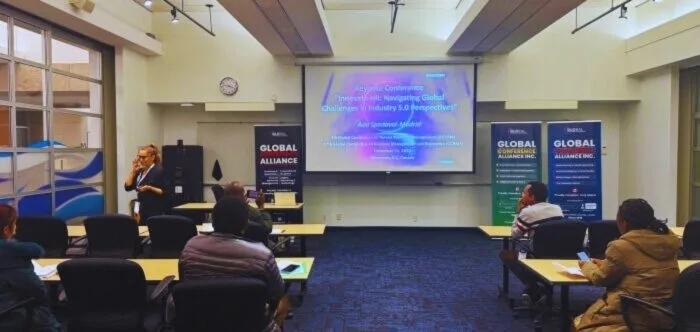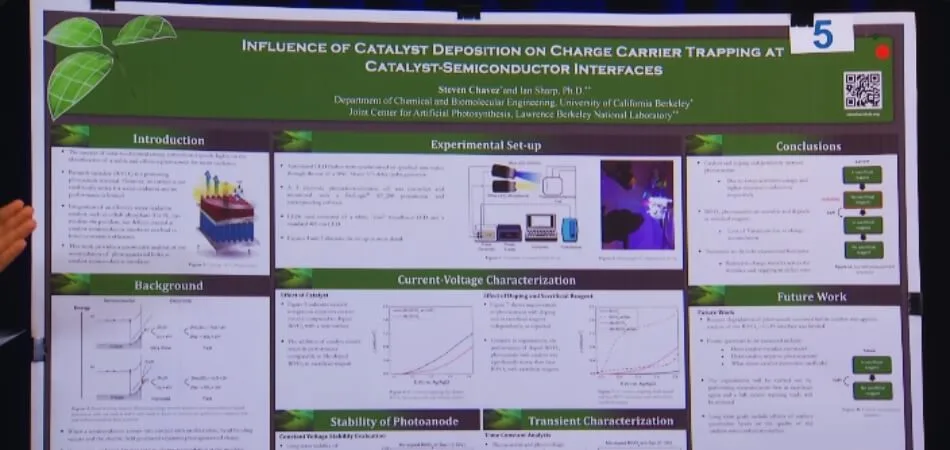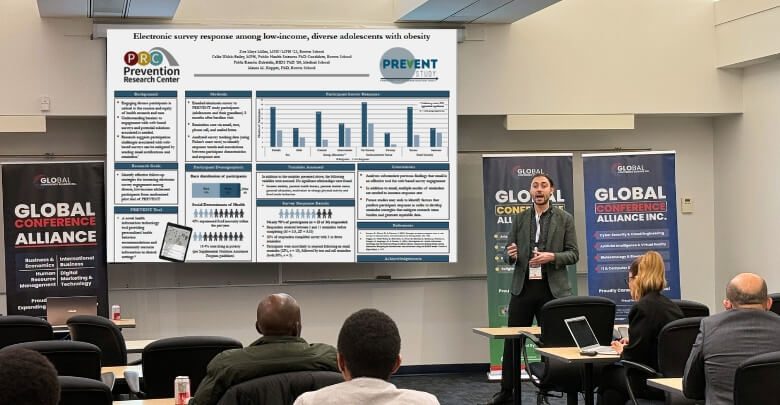Conference posters, often a blend of insightful research and creative design, serve as a key component in academic and professional presentations. But what to do with poster after conference? This question is more common than one might think.
You can breathe new life into your poster by displaying it in your office or lab as a testament to your work. Alternatively, sharing it on academic social media platforms can amplify its reach and impact. Using it as a visual aid in future presentations can also be highly effective.
If these options don’t fit, consider recycling the poster. Curious about more detailed tips and innovative ideas? Continue reading to explore how you can maximize the afterlife of your conference poster.
What the Conference is About?
Conferences are active gatherings that bring together experts from various fields. They provide a platform for sharing ideas, research findings, and innovations. These events foster networking, collaboration, and the exchange of cutting-edge information.
The topics at a conference can range widely, depending on the focus area. Science and technology, arts, business, and education are common themes. Attendees gain insights from keynote speeches, panel discussions, and interactive sessions.
At the heart of every conference organized globally is the opportunity for professional growth and learning. Participants leave with new knowledge, skills, and connections. Such events are pivotal in shaping future trends and directions in their respective fields.
Significance of Posters in Conferences
Conferences are hubs of knowledge and innovation, where ideas take visual form. Posters play a crucial role in this intellectual exchange. They serve as a concise and engaging medium for presenting complex information.
- Posters offer a snapshot of research or ideas, making complex topics easily digestible. They’re designed to attract attention and generate interest among attendees.
- They facilitate direct interaction between the presenter and the audience, encouraging in-depth discussions and networking. This personal engagement is vital for academic and professional growth.
- In these visual displays, key findings and data are highlighted. This makes understanding and retention of information easier for viewers.
- Posters are tools for researchers to receive feedback and suggestions. Such interactions often lead to collaborations and new insights.
- They act as a creative outlet, allowing presenters to showcase their work innovatively. Effective design can significantly impact the audience’s understanding.
- For many, especially students and early-career researchers, posters are a stepping stone. During international conferences, they provide a platform for presenting research findings.
Posters at conferences are more than just paper and ink; they are catalysts for conversation and discovery. They bridge the gap between complex ideas and their audience, fostering a rich exchange of knowledge.
Types of Posters Used in Conferences
Conferences are a melting pot of ideas, where posters play a pivotal role in communication. These visual tools come in various types, each tailored for different purposes and audiences. Understanding these types helps presenters choose the most effective way to convey their message.
Research Posters
Research posters are common in academic and scientific conferences. They present data, hypotheses, and results from recent studies. Their design focuses on clarity and precision, using graphs and charts. These posters aim to spark discussions and invite peer feedback.
Case Study Posters
Case study posters delve into specific instances or projects, providing detailed analysis. They often tell a story, outlining challenges, solutions, and outcomes. These posters are instrumental in highlighting practical applications of theories or techniques. They are ideal for sharing real-world experiences and learning.
Informational Posters
Informational posters aim to educate or inform about a particular topic or issue. They are less data-driven and more focused on clear, concise messaging. These posters use engaging visuals and easy-to-understand language. They’re great for broad audience engagement and awareness spreading.
Instructional Posters
Instructional posters are designed to teach or guide processes and methodologies. They break down complex procedures into simpler, understandable steps. Visual aids like flowcharts and diagrams are commonly used. These posters are useful in workshops or training sessions.
Promotional Posters
Promotional posters are used to advertise events, products, or services. They prioritize eye-catching designs and compelling taglines. The goal is to create interest and attract participants or customers. These posters are more common in trade and industry conferences.
Interactive Posters
Interactive posters incorporate elements that engage the audience directly. They may include QR codes, touch screens, or augmented reality features. These posters encourage active participation and can create memorable experiences. They’re becoming increasingly popular in the digital age.
The variety of posters used in conferences serves different needs and objectives. From detailed research presentations to engaging interactive displays, each type plays a unique role in the rich tapestry of conference communication. Understanding these types empowers presenters to effectively share their knowledge and connect with their audience.
What to Do With Poster After Conference?
Conferences conclude, but the life of a poster doesn’t have to. These visual summaries of hard work and research hold ongoing value. Exploring post-conference uses for posters can extend their impact and utility.
Display in Your Workspace
Displaying your poster in your office or lab serves as a reminder of your achievements. It can inspire colleagues and spark conversations about your work. Such displays foster a culture of sharing knowledge and ideas. It’s a great way to keep the essence of your research alive.
Share on Academic Platforms
Academic social media platforms are ideal for sharing your poster with a wider audience. Uploading it to platforms like ResearchGate or Academia.edu can increase its visibility. This digital sharing invites global academic engagement and feedback. It’s an effective way to network and collaborate with peers.
Use as a Teaching Aid
Posters can be repurposed as teaching aids in classrooms or workshops. They help explain complex topics in a visually appealing manner. This reuse is particularly beneficial for educators and trainers. It’s an efficient way to reinforce learning through visual means.
Incorporate into Future Presentations
Your poster can be integrated into future presentations or lectures. It serves as a succinct summary of key points. This approach is useful for reinforcing messages in a different context. It’s a practical way to recycle content for various audiences.
Contribute to a Public Display
Consider donating your poster to public spaces like libraries, schools, or community centers. These venues appreciate educational material for display. It’s a way to contribute to public knowledge and inspire others. Your research could spark interest in a new generation of learners.
Recycle If Necessary
If the poster has served its purpose and is no longer needed, recycle it responsibly. This is important for environmental sustainability. Ensure the materials are disposed of in an eco-friendly manner. It’s a small but significant contribution to reducing waste.
The end of a conference is just the beginning for your poster. With these strategies, you can maximize its value and impact. Whether through sharing, teaching, or recycling, your poster can continue to contribute long after the conference lights dim.
Consideration While Reusing Conference Poster
Reusing a conference poster is an excellent way to extend its value beyond the event. However, it’s important to do so thoughtfully and effectively. Considerations should be made to ensure the poster remains relevant and impactful.
- Context Appropriateness: Ensure the poster’s content is suitable for the new setting or audience. It might require tweaking to fit different contexts.
- Update Information: If any data or information has become outdated, update it before reusing the poster. This maintains the poster’s credibility and relevance.
- Quality Preservation: Check the physical condition of the poster. Damaged or worn posters might need repairs or reprinting for further use.
- Permission and Acknowledgments: If the poster includes collaborative work, get consent from co-authors or contributors before reusing it. Also, acknowledge their contributions.
- Audience Adaptation: Tailor the content to suit the knowledge level and interests of the new audience. This ensures better engagement and understanding.
- Legal Considerations: Respect intellectual property rights. If the poster includes copyrighted material, ensure you have the right to reuse it.
- Environmental Impact: Consider the environmental impact of reusing physical posters. Opt for digital versions if possible to reduce waste.
Reusing a conference poster can be a sustainable and effective way to disseminate information. However, it requires careful consideration to ensure that the poster remains accurate, relevant, and respectful of intellectual property and environmental concerns.
Essential Steps to Preserve Conference Poster
Preserving a conference poster is crucial to retain its value and ensure it remains a valuable resource long after the event has ended. These steps can help safeguard your poster, protecting not only its physical integrity but also the valuable information it contains.
Proper Storage
When not in use, store the poster in a cool, dry place to prevent moisture damage and avoid direct sunlight, which can fade colors. Use acid-free materials such as archival quality tubes or folders to protect it from environmental factors.
Handling with Care
Always handle the poster gently, as excessive bending or creasing can cause permanent damage. Use clean, dry hands to avoid smudging the ink or staining the paper. When rolling or unrolling it, do so carefully to prevent tears.
Reinforce Edges
Over time, the edges of a poster may start to fray. To prevent further deterioration, consider reinforcing the edges with clear, acid-free tape or adhesive strips. This simple step can significantly prolong the poster’s life.
Digital Backup
Create a digital backup of the poster by scanning or photographing it. Store the digital copy on multiple devices or cloud storage for safekeeping. This ensures you have a backup in case the physical poster gets damaged or lost.
Frame or Lamination
For long-term display and protection, consider framing the poster or laminating it. Framing not only enhances its visual appeal but also shields it from dust and physical contact. Laminating provides a protective plastic coating that prevents moisture and dirt from affecting the poster.
Regular Inspection
Periodically inspect the poster for any signs of deterioration, such as discoloration, fading, or damage. Address issues promptly by taking appropriate conservation measures. Consult a professional conservator if needed.
Preserving a conference poster involves comprehensive steps to ensure it remains in excellent condition for years to come. Proper storage, careful handling, and regular maintenance are essential to extend the life of your poster and preserve its valuable content.
Bottom Line
In our discussion, we focused on the effective reuse of conference posters. Key strategies included digital archiving for easy access and sharing, and utilizing the poster in educational settings to enhance learning.
Central to our conversation was “What to do with poster after conference?”. This led to ideas like adapting the content for academic publications and presentations, thereby extending the poster’s life and academic relevance.
We also highlighted the importance of networking and sustainability. Sharing the poster within professional networks can amplify its impact, while recycling its materials promotes environmental responsibility, making the most of the conference experience.








